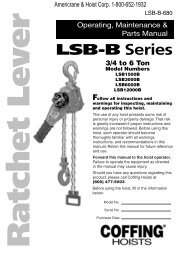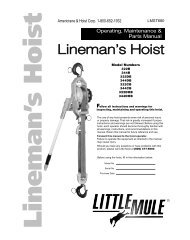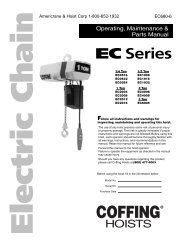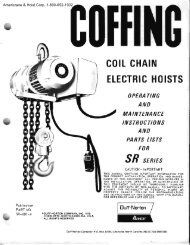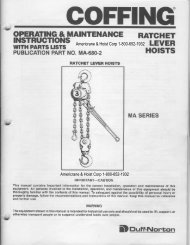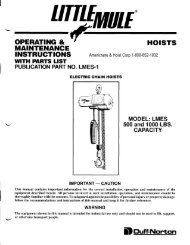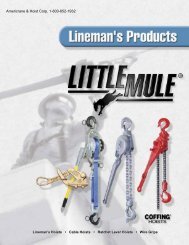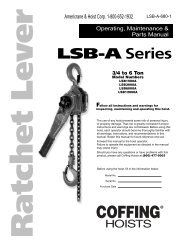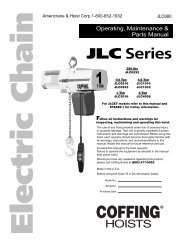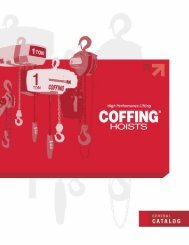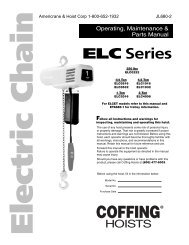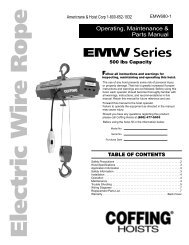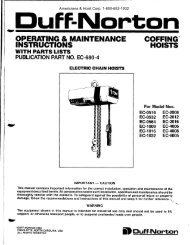ELCMT Series, JLMT 680-1 - Coffing Hoists, Coffing Hoist Parts
ELCMT Series, JLMT 680-1 - Coffing Hoists, Coffing Hoist Parts
ELCMT Series, JLMT 680-1 - Coffing Hoists, Coffing Hoist Parts
- No tags were found...
You also want an ePaper? Increase the reach of your titles
YUMPU automatically turns print PDFs into web optimized ePapers that Google loves.
Country Club RoadP.O. Box 779Wadesboro, NC 28170 USATEL: (800) 477-5003FAX: (800) 374-6853TROLLEY REPAIRSIf you do not have an experienced mechanic/electrician to doyour repair work, we recommend that you sendyour hoist to an approved service center for repairs. Useauthorized repair parts only. The following are instructions forminor repairs that may not require a service center.ELECTRICAL PARTSThe trolley motor controls include a reversing contactor, and, inthe case of 2-speed motors, a speed control relay. Thesecomponents are located under the hoist electrical cover or in aseparate trolley control box (See Figures 19 and 21). SeeELECTRICAL PARTS AND BRAKE, page 12, for moreinformation on replacing electrical parts.TROLLEY MOTOR1. If it is necessary to replace or repair the motor,DISCONNECT THE UNIT FROM THE POWER SUPPLY,and remove the splice plate on the trolley junction box.2. Disconnect the motor leads from the tie cable. Be sure thatall the wires retain their markings.3. Remove the four motor mounting bolts and pull the motoraway from the trolley transmission.4. Inspect the motor shaft and all the bearings, replace asnecessary.5. Install the new or repaired motor according to the wiringdiagram intended for your unit (See Figures 12A - 12F forstandard diagrams).TROLLEY WHEELSWorn wheels should be replaced with new assemblies.Remove the locknut from the wheel shaft and remove theassembly. Replace with a new assembly, which includes a newlocknut. Be sure to replace the washers and tighten nuts to 100ft-lbs.Remove load and disconnect hoist from power supplybefore starting to do any repairs or to take anysections apart.POWER CORD PRECAUTIONS WITH 1-PHASE HOISTSElectric hoists require a sufficient power supply. It is especially important with single-phase voltage to ensure that theconductors running to the hoist from the power source are adequate in size to handle the power requirements of the hoist.Inadequate power cables and branch circuits will cause low voltage, high amperage, damage to the hoist, and potential firehazards. Such problems can be minimized by using 230V power on 115/230V hoists. The following are recommendations for theconductor gage size depending on the length, horsepower, and voltage.Table 4 - Recommended Conductor Sizes for 1-Phase <strong><strong>Hoist</strong>s</strong>Maximum Length of Power Cord in FeetVoltageHP (1-Phase) 14 AWG 12 AWG 10 AWG 8 AWG1/4 115V 75 120 190 300230V 350 560 9001/2 115V 40 60 100 150230V 200 330 520 8101 115V 0 30 50 75230V 120 190 310 49014



